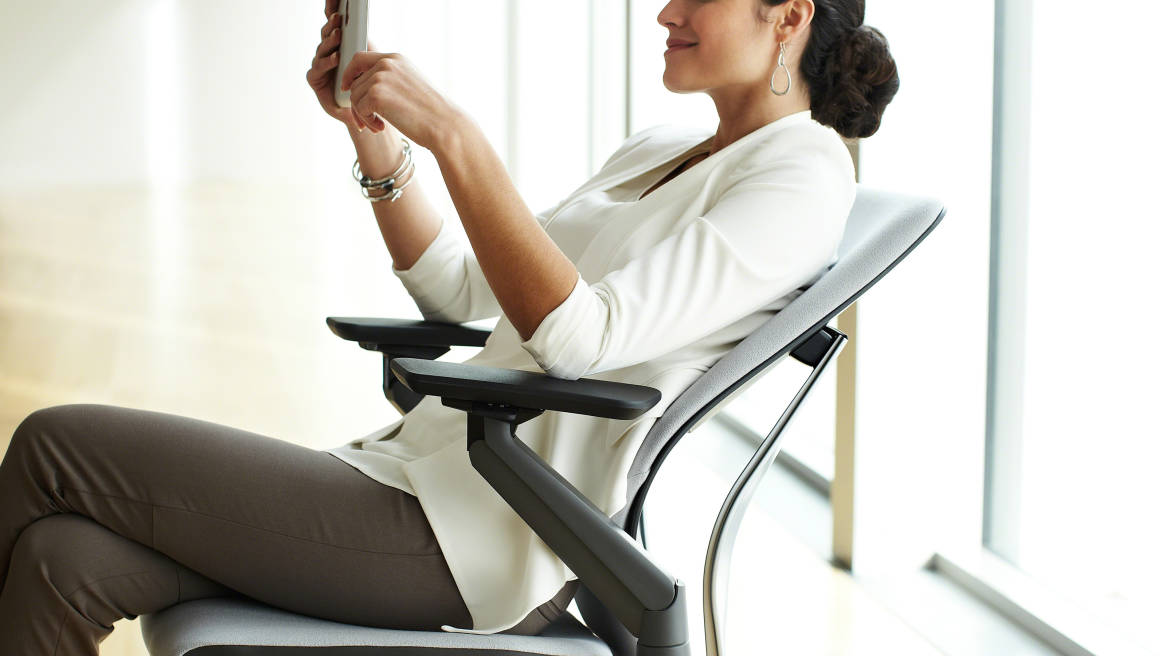Text Neck
Got Text-Neck? The Solution Could Be Your Arms!
By Christine Congdon
The arms of your chair that is.
Text neck is getting a lot of media attention these days because more and more people are suffering from it. Doctors – realizing that the increased incidence of neck pain was associated with people spending more hours gazing down at technology devices – dubbed the affliction “text neck” and it seems like everyone’s got. It. That’s because we’re all using devices throughout our day. According to a recent study conducted by Steelcase of over 11,000 workers around the world, 45% use three devices – a laptop, a tablet and a smartphone – and 13% use four devices. People regularly toggle between these devices to check e-mail, text, read and compose documents. It’s how work gets done today. And while some doctors might debate whether text neck actually causes spinal damage, the pain people experience when spending too much time looking down at their devices is very real. So what does your chair have to do with it?
The solution to text neck is pretty obvious: improve your posture. There are even new technology devices aimed at improving your poor posture caused by… technology devices. One gadget gently buzzes when you begin to slouch forward too much, encouraging you to straighten up. Fixing your posture is tough.
“The body follows the eyes,” notes ergonomist Carol Stuart-Buttle. The average human head weighs about 10 pounds, and as people look down at mobile devices, the force on the back of the neck begins to increase. Overtime, the natural curve of the neck can flatten out leading to pressure on the discs and nerves in the back and neck, causing a lot of pain. Bent at a 15-degree angle the head adds 27 pounds of pressure to the neck and at a 60-degree angle its 60 extra pounds of pressure. And when we spend our days working on multiple devices our heads can feel awfully heavy.
I don’t remember exactly when my neck pain started, but I vividly recall the day it hurt so badly it brought tears to my eyes. So I did what most busy people do – I gulped down some ibuprofen, slapped on some Icy Hot, did a couple neck stretches and got back to work. I’m a mobile worker at Steelcase so I have a lot of great ergonomic seating options, but I wasn’t always making the best choices for the type of work I was doing. And my neck pain kept coming back despite my good intentions.
I wasn’t alone. In fact, shortly after the advent of the ipad in 2010, Steelcase researchers and designers began noticing people working in significantly different postures as mobile devices became more prevalent at work. They saw workers hunched over texting, and slouching to type on their laptops. They conducted a global study of 2,000 people in 11 countries and identified nine new ways people were sitting because of their technologies. The chairs people were sitting in had been designed before these new technologies became a regular part of our work day and so they didn’t support these new postures.
Our designers created a chair called Gesture, which helps support the body in a huge range of postures, but especially when using mobile technology. It features arms that move in a complete 360 degree motion, like the human arm. They adjust snug to the body, which allows people to prop their arms up, and hold handheld devices in front of their face instead of in their lap. This helps keep the head neutral and eyes straight forward. Just as the doctor ordered.
I started using the Gesture chair at work and even bought one for my home office. I followed our ergonomists’ advise and focused on changing postures throughout the day, including standing or walking when possible. I stretched my neck and used Gesture’s arms to support my arms as I scanned through e-mail on my phone or read documents on my ipad. I don’t remember exactly when it happened, but one day I noticed that my neck didn’t hurt anymore.
So the next time you’re on your device and you feel the pain of “Text Neck” starting, think about your arms. Ibuprofen and an occasional roll of the shoulders won’t undo the damage that gazing down causes. If you want to save your neck, consider your arms – and a chair that supports them.
What posture do you use most? Check out the nine new postures from Steelcase’s Global Posture Study and let us know today! To see where you sit compared to others, check out our real-time infographic of posture survey results from around the globe.
 Christine Congdon is Editor of 360 Magazine and Director or Research Communications at Steelcase. She co-authored “Balancing We and Me: The Best Collaborative Spaces Also Support Solitude” in the October issue of Harvard Business Review. Chris has written about workplace issues in Fast Company, CNBC, HBR Blog Network and speaks at conferences such as Corenet, PopTech and Neocon. You can follow her on Twitter (@cscongdon) and LinkedIn.
Christine Congdon is Editor of 360 Magazine and Director or Research Communications at Steelcase. She co-authored “Balancing We and Me: The Best Collaborative Spaces Also Support Solitude” in the October issue of Harvard Business Review. Chris has written about workplace issues in Fast Company, CNBC, HBR Blog Network and speaks at conferences such as Corenet, PopTech and Neocon. You can follow her on Twitter (@cscongdon) and LinkedIn.


